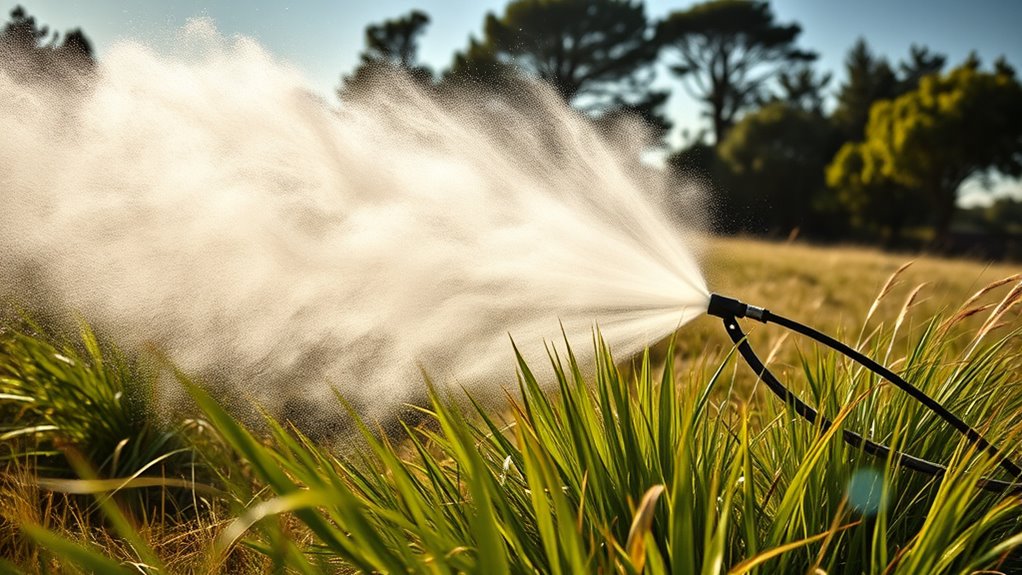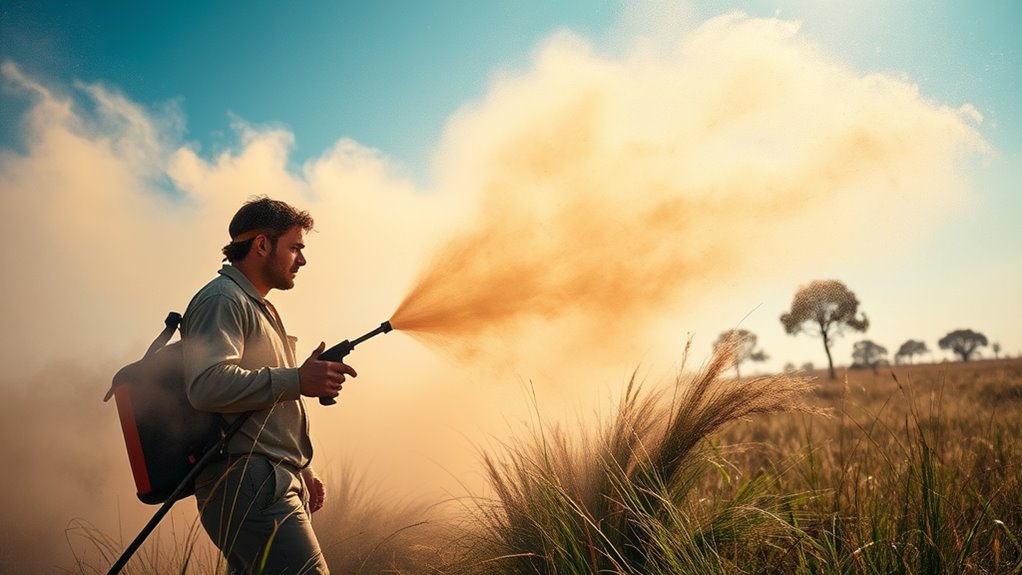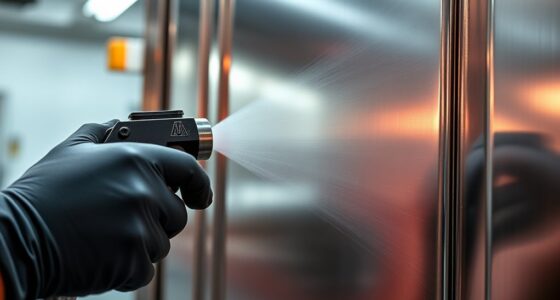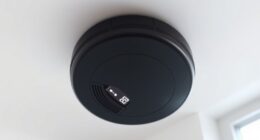When spraying outdoors in windy conditions, you should check weather forecasts and avoid spraying if winds exceed recommended limits, typically around 10 mph. Use low-drift nozzles, keep spray height close to the target, and lower your pressure to produce larger droplets. Always wear protective gear and aim spray away from non-target areas. Monitoring wind shifts during application is essential. If you want to guarantee safe, effective spraying despite the wind, keep going to discover more tips.
Key Takeaways
- Check weather forecasts and avoid spraying when wind speeds exceed recommended limits, typically around 10 mph.
- Use low-drift nozzles and adjust spray pressure to produce larger, less airborne droplets.
- Keep spray height close to the target to minimize droplet dispersion caused by wind.
- Wear protective gear and aim spray away from non-target areas to ensure safety during windy conditions.
- Continuously monitor wind direction and speed, pausing or adjusting application if conditions change.

Have you ever wondered how wind affects spraying applications? When you’re working outdoors, wind can appreciably impact how your spray disperses, making it harder to target pests or weeds accurately. To ensure your application is effective and safe, understanding drift mitigation and safety precautions becomes essential. Wind increases the risk of spray drift—a phenomenon where droplets are carried away from their intended target by air currents. This not only reduces the efficiency of your treatment but also poses environmental and health risks to nearby people, animals, and sensitive plants. That’s why, when wind speeds pick up, you need to adapt your approach to minimize these hazards.
First, you should always check local weather conditions before starting your spraying task. If wind speeds exceed recommended limits—often around 10 mph or less, depending on the product—it’s best to postpone spraying. When you do proceed, employ drift mitigation strategies, such as using low-drift nozzles that produce larger droplets less prone to being blown away. Adjusting your spray pressure can also help; lower pressure results in coarser droplets that are less likely to drift. Additionally, maintaining an appropriate spray height—closer to the target without risking contact—reduces the distance droplets travel through the air, further decreasing drift potential.
Safety precautions are paramount when spraying in windy conditions. Wear protective gear, including masks, gloves, and goggles, to shield yourself from unintended exposure. Be mindful of wind direction, and always aim your spray away from non-target areas like roads, neighboring properties, or water bodies. If wind shifts unexpectedly during spraying, pause your operation to reassess conditions rather than risking accidental drift. Set up physical barriers or buffer zones if possible; these can block or reduce spray movement toward sensitive areas. Also, communicate with others nearby about your spraying schedule so they’re aware of potential hazards.
Frequently Asked Questions
How Can I Tell if Wind Speed Is Too High for Spraying?
You can tell if wind speed is too high for spraying by checking wind speed measurements with a reliable weather app, but remember, weather app accuracy may vary. If the wind exceeds 10-15 mph, it’s generally unsafe to spray because it can cause drift. Always monitor real-time updates, and if in doubt, wait for calmer conditions to ensure safety and effectiveness.
Are There Specific Equipment Modifications for Windy Conditions?
Yes, you should consider equipment modifications for windy conditions. Opt for nozzles with specialized designs that reduce drift and improve accuracy, enhancing equipment durability. Use nozzles with larger droplet sizes to minimize wind impact and wear on your equipment. Additionally, choose a sprayer with reinforced components built for tougher conditions. These adjustments help you maintain effective application, safeguard your equipment, and ensure safety despite the challenging weather.
What Environmental Impacts Are Caused by Spraying in Windy Weather?
When you spray in windy weather, you risk causing air and water contamination as pesticides drift away from your target area. This can also disturb wildlife, disrupting their habitats and behaviors. Wind spreads chemicals unpredictably, increasing environmental harm and reducing application efficiency. To protect ecosystems, avoid spraying in windy conditions or take precautions to minimize drift and contamination, ensuring safer, more responsible pest control.
How Can I Protect Nearby Non-Target Plants From Drift?
To protect nearby non-target plants from drift, you should implement drift mitigation strategies like adjusting your spray equipment and using drift-reduction nozzles. Additionally, establish buffer zones around your target area, which act as a barrier to prevent pesticides from reaching unintended plants. Always monitor wind conditions and avoid spraying during high winds, as this markedly reduces drift risk and helps safeguard surrounding vegetation.
What Are the Legal Restrictions on Spraying During Windy Days?
You shouldn’t spray during windy days without checking regulatory compliance and licensing requirements. Many regions restrict pesticide application in high wind conditions to prevent drift and environmental harm. Always review local regulations before spraying, as violating them can lead to fines or license suspension. Making sure you follow these rules helps protect nearby plants and maintains safe, lawful pesticide use. When in doubt, wait for calmer weather to ensure safe, compliant spraying.
Conclusion
So, next time you think about spraying in windy weather, remember—your best intentions to protect your crops might just backfire. Ironically, those gusts meant to carry away pests could also carry away your spray, leaving your efforts wasted. Don’t let a gust ruin your day or your crop. Take the time to wait for calmer conditions. After all, a little patience now saves a lot of frustration—and money—later.









